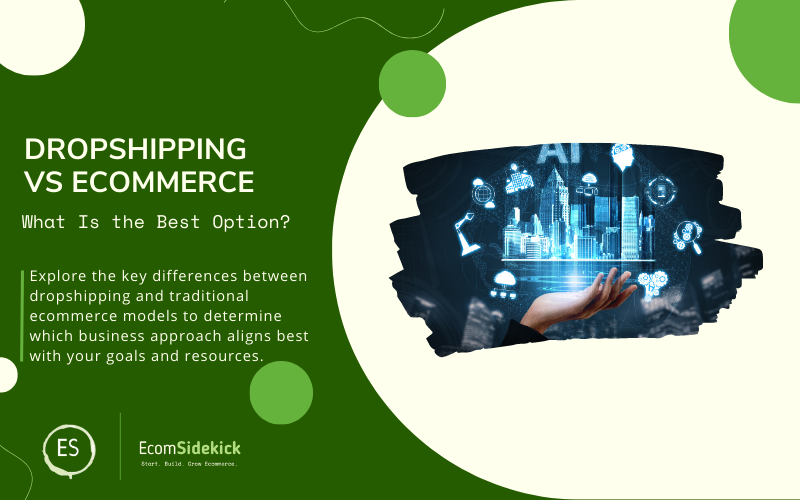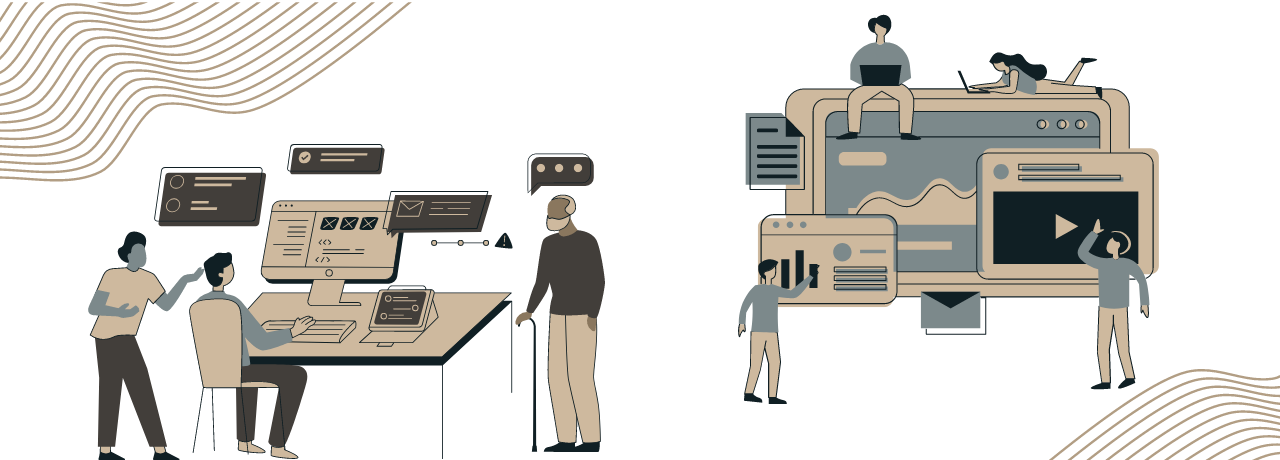Nowadays, the internet is the main spot for conducting business of all kinds, from bakeries to car sales.
Besides making business owners lives easier, providing customer service through online platforms is much easier for everyone. Because of this, eCommerce marketplaces and dropshipping businesses are growing with every day that passes. But which one is best? On the debate of Dropshipping vs Ecommerce, let Ecomsidekick help you with this article!

Ecommerce platforms are a rising trend for income now more than traditional methods. You only need a good website and select the best business model on paper. Suppose you are researching to be an online retailer or just a business in general. In that case, you have to be aware of e-commerce fulfillment methods, and different fulfillment approaches.
What Is a Fulfillment Center?
A fulfillment center is the department of a company where items are processed and packaged. They are a warehouse space where your product inventory is temporarily stored. Now, for your fulfillment center, you can opt for a simple storage room, and it can go all the way to a large dedicated warehouse.
This really depends on the scale of your business.
For online businesses, two main e-commerce fulfillment services are available. These business models include eCommerce and dropshipping. However, there is a debate about the benefit of dropshipping vs eCommerce, which makes for a better delivery experience?
Now, let’s walk through what dropshipping and eCommerce fulfillment processes are and which is the right one for you.
How to Choose?
Dropshipping vs eCommerce, how do you know which option you should choose and when?
To answer this question, you should learn about both options’ pros and cons. Both options are entirely different business models and have the potential to hugely influence the growth of your online marketplaces while giving you larger profit margins.
While considering whether dropshipping or eCommerce is the best fulfillment model, you need to consider the following key aspects to make your business grow fast and effectively:
- Will it help you keep your profits up?
- What is the initial investment?
- Does it have simple scalability?
- Will it demand your marketing skills?
- Does it allow for flexibility?
- How easy is it to create your brand?
How Does Ecommerce Work?
The eCommerce sales business model is the usual fulfillment method for online stores; it works as an umbrella term for selling items/services online. This includes items you use on a daily basis, like clothing, shoes, jewelry, home accessories, food, and whatever else you can think of.
A potential customer accesses your website, skims the available items, and places their order. The payment is made via debit card, and the order is sent for further processing. The fulfillment center receives these customer orders, packs them, and labels them. Lastly, the courier services deliver the order to your doorstep.
Features of E-commerce
Features | Details |
Fulfillment Centre | With an eCommerce fulfillment process, you will need a warehouse. Which is not exactly a con, especially if you’re a small business owner. But, on the other hand, if your business begins to grow, you will have to scale up to handle how to get products to customers and their satisfaction. |
Tracking | If you are taking care of an eCommerce fulfillment center, you must keep track of orders and products, ensuring more items are available if needed. Whether you own a large-scale business or not, ensuring good product quality is the aim. If you are into marketing branded products, following this business plan would be ideal. |
Control | In an eCommerce model, the service is for sellers who want to control the quality of their product going out to the customer and take responsibility for customer experience. |
Catalog | If your business has a tipping culture, no extra fees will be added on tips to customers or you. |
How Does Dropshipping Work?

The other significant eCommerce business model is dropshipping. The gist of the concept behind dropshipping is that such online stores that do not have a fulfillment center within themselves team up with an external vendor known as the dropshipper.
They are responsible for handling the orders and having them to the customers effectively. Dropshipping business models essentially differ from the normal eCommerce fulfillment route.
Pros and Cons of Dropshipping:
No Inventory: You own the online business store without the inventory. Your customers visit the website, place their orders, and pay online. The next step is to place a similar order to your dropshipper. The rest of the order processing and delivery at customers’ homes is the responsibility of the dropshipper.
Massive Responsibility: The retailer’s responsibility in this dropshipping model relies on managing customer relations and enjoying passive income. Just like eCommerce, this business model is rapidly growing in the market.
Control: The dropshipper holds complete control of the inventory. It is like two companies coordinating with each other. The customers have no idea what exactly happens behind the scenes or where they place their orders. Dropshipping is a deal between two companies working to receive and handle customer orders.
An important thing to remember here: dropshipping is not the same as third-party logistics. In third-party logistics, you own the inventory; just the responsibility of direct customer contact and order processing is of an external vendor. Unlike third-party logistics, in the case of dropshipping, the stock is totally out of the picture.
Similarities Between Dropshipping and Ecommerce
Now that you know the fundamentals of the most popular fulfillment methods, let’s compare the two to see how they differ and their similarities. Additionally, towards the end, you will have an idea of which of these options works best for you.
It is easy to differentiate between the two marketing strategies. However, they do have some similarities.
Websites
Having a website is the major and most obvious similarity between eCommerce and drop shipping. In both, the business owner must create their websites. Uploading the product catalog to sell products online is essential to an online business.
Once you have had successful contact with customers, advertise and market your products. As your business grows, a capable workforce of customer service agents ensures a smooth-running business. In both cases, the developer must come up with an effective plan.
Marketing and Advertising
In dropshipping and eCommerce models, marketing and advertising are crucial. Both have similar practices for marketing and advertising, such as email marketing, multiple platforms, and search engine optimization.
Catalog
In dropshipping and eCommerce, cataloging is used. On the website, the retailer provides a list of items on sale. Customers go to the online website, skim through the items and place their orders. Payment is also made online in both cases.
Differences Between Dropshipping and eCommerce
Inventory Ownership
As discussed earlier, the critical difference between eCommerce fulfillment and dropshipping is inventory ownership. In the case of eCommerce, the online store owner has his inventory, including online services advertised on the website. On the other hand, the dropshipping business requires the business owner to contact the vendors for order fulfillment.
Structure
The second difference is somewhat linked to the first one in that if a business owner got to have his inventory, he must have a concrete structure to keep the stock. This requirement is not mandatory if you are teaming up with a dropshipper.
Control
The third main difference is the control over the flow of processes. Owners of eCommerce businesses have complete control over the entire process, from customers’ online orders to the delivery of products at their homes.
At the same time, the dropshipping business model has minimal control over the processes. The business owner only has powers limited to customer orders, and inventory management is the dropshipper’s task.
Initial Investment
Lastly, the initial investment is an essential factor in eCommerce fulfillment. Once you decide to go with it, you must devise a budget for the upfront costs like inventory, shipping, and warehouse. However, this is not a necessary condition for a dropshipping store owner.
So Which Business Model Is the Best for You?
You should go for an eCommerce business model when you have sufficient funds to deal with initial investments easily. If you are willing to sell your brand’s products and have complete control over your order fulfillment, opening an eCommerce store is the right path.
On the other hand, dropshipping is a relatively safe option for new entrepreneurs. Hence, you can avoid substantial start-up investments using this business model. On top of that, dropshipping makes you deal with minimum damage if you expect the risk of unsold inventory. Lastly, go with this option when you are not looking to market branded products or sell your items.
But considering the key aspects we discussed at the beginning of this article, ecommerce seems like the better option despite higher risks and investments.
Dropshipping vs Ecommerce: Final Thoughts

If you are all geared up to embark upon the world of online business, opting for the right business plan is crucial to achieving a successful online business. Order fulfillment methods have a considerable impact on how successful your business can be.
However, sellers can easily approximate this impact by evaluating how quickly they deliver orders to the clients. While in an online business, going for the right fulfillment center must be your number one priority.
Both dropshipping and eCommerce business models help you in different ways. Hence, the main point is that the business owner must figure out what plan works best for them. With the correct mindset and enough knowledge, you can take your online business to the next level and gain profit margins.
Frequently Asked Question
Which Model Is More Suitable for Beginners: Dropshipping or Ecommerce?
For beginners, dropshipping is often considered more accessible and less risky. It requires less upfront investment as you don’t need to purchase inventory in advance. With dropshipping, you can test various products and niches without a significant financial commitment. Traditional ecommerce, on the other hand, requires more capital to purchase and store inventory, which might be more challenging for those starting with limited funds.
Which Model Offers Higher Profit Margins: Dropshipping or Ecommerce?
Profit margins in dropshipping tend to be lower compared to traditional ecommerce. In dropshipping, you pay the supplier for the product and often a wholesale price, leaving a smaller profit margin. In traditional ecommerce, you purchase products at a lower wholesale cost and set the retail price, allowing for potentially higher profit margins. However, traditional ecommerce comes with inventory costs, whereas dropshipping has lower upfront expenses.
What Are the Main Challenges With Dropshipping and Traditional Ecommerce?
Dropshipping challenges include issues with product quality, shipping delays, and reliance on suppliers. As you don’t control inventory, you might face challenges with out-of-stock items or poor product quality from certain suppliers. Traditional ecommerce challenges involve managing inventory, warehousing, and fulfillment logistics. Inventory management can lead to dead stock and higher costs, especially if demand fluctuates.
Which Model Is Better for Scaling a Business: Dropshipping or Ecommerce?
Traditional ecommerce is generally better for scaling a business in the long term. While dropshipping offers low barriers to entry, it might be limited in terms of scalability due to lower profit margins and potential issues with supplier relationships. With traditional ecommerce, you have more control over product quality, branding, and fulfillment, allowing for better customer experiences and opportunities for growth.
Which Business Model Is Better for Beginners: Dropshipping or Ecommerce?
For beginners, dropshipping is often considered a more accessible option. It requires less upfront investment as there is no need to purchase inventory upfront. Dropshipping also eliminates the need for warehouse storage and fulfillment logistics. On the other hand, traditional Ecommerce can be more complex, requiring inventory management and shipping logistics. The choice between the two depends on individual preferences and business goals.
Paul Martinez is the founder of EcomSidekick.com. He is an expert in the areas of finance, real estate, eCommerce, traffic and conversion.
Join him on EcomSidekick.com to learn how to improve your financial life and excel in these areas. Before starting this media site, Paul built from scratch and managed two multi-million dollar companies. One in the real estate sector and one in the eCommerce sector.

